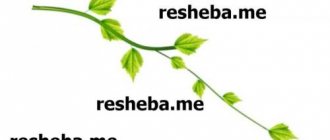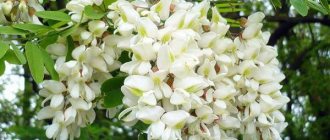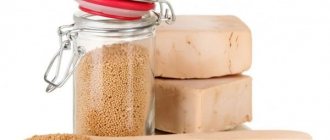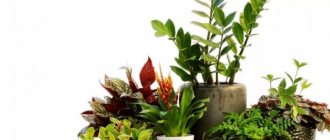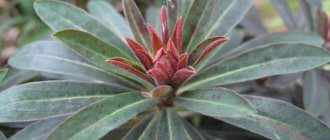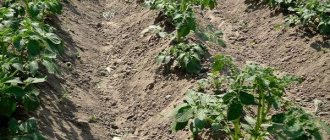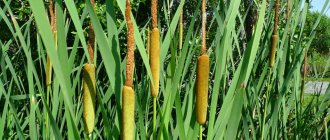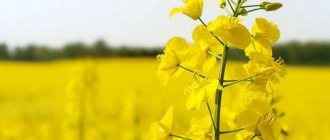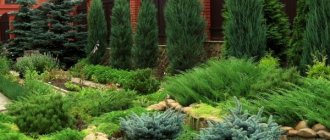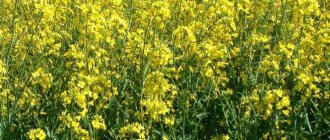Plants are indicators of special soil characteristics
Many plants have adapted to a certain habitat, therefore, based on their presence on the site, one can draw a conclusion about the structure, chemical composition and reaction of the soil, the degree of its fertility, and the level of groundwater. This information is often confirmed by conducting research on the site and laboratory tests of the soil from it.
Plants are indicators of soil fertility
Plants such as nettle, raspberry, fireweed, meadowsweet, hoofed grass, celandine, valerian, wood sorrel, meadow rank, and awnless brome grow on highly fertile soils. On soils of average fertility - longleaf speedwell, angelica, river grass, wintergreen, lungwort, two-leafed grass, swimwort, fescue. If lichens, mosses, lingonberries, white grass, fragrant spikelet, cat's paw, cranberries, and filamentous rush are found on the site, it means that the soil here is characterized by low fertility.
TO IDENTIFY THE MOST SHADED AREAS IN THE VEGETABLE GARDEN, it is recommended to identify shadows from buildings, tall trees and fences at 8-9, 12-13 and 17-18 hours. Then shade these places on the site plan. Where the shading overlaps is where the shadow will be the thickest.
Plants are indicators of soil chemistry
Some plants can indicate a pronounced accumulation or deficiency of certain chemicals.
When there is a large amount of nitrogen in the soil, plants such as chickweed, raspberry, nettle, groundsel, fireweed, quinoa, and ranunculus appear. Cinquefoil, tenacious bedstraw, wheatgrass, and knotweed grow in meadows and plowed areas. All these plants are bright green. A lack of nitrogen is indicated by the pale green color of plants and a decrease in the number of branches and leaves. In such conditions, wild carrots, sedum, and navel grow.
With a high calcium content in the soil, legumes grow well, especially alfalfa, as well as Siberian larch. If there is a lack of calcium and the soil becomes more acidic, then plants such as sorrel, white grass, turfgrass, and sphagnum appear. They tolerate the accumulation of aluminum, iron, and manganese salts in the soil.
Back
Plants are indicators of soil moisture levels
Plants adapted to very humid environments are called hygrophytes. They live mainly in wetlands. These include wild rosemary, wild rosemary, snakeweed, blueberry, meadow geranium, field mint, cloudberry, forest reed, marigold, marsh cinquefoil, spleenwort, and meadowsweet.
Mesophytic plants are common on moist soils, but not wetlands. These are meadow and forest herbs: lingonberry, hedgehog grass, cornflower, mouse pea, meadow clover, stoneweed, hoofweed, European bathwort, meadow foxtail, creeping wheatgrass, meadow heartgrass, timothy, meadow rank, club mosses, solidago, sorrel.
Dry soils are preferred by xerophytic plants - feather grass, cat's foot, various types of sedum (large, caustic, purple), white bentgrass, wormwood, chamomile, bearberry, hairy hawkweed, as well as terrestrial lichens.
Back
Plants indicators of groundwater levels
The depth of groundwater can be determined using indicator plants, divided into 5 groups. If several plants from the same group are found on the site or a certain plant has grown, then the groundwater level can be determined accurately.
1 group. In areas where groundwater is located at a depth of more than 1.5 m, predominantly meadow clover, awnless brome, large plantain, and creeping wheatgrass grow.
2nd group. When groundwater occurs at a depth of 1–1.5 m, mouse peas, meadow bluegrass, meadow fescue, white bentgrass, and meadow grass grow abundantly.
3rd group. In areas with shallow groundwater (0.5–1 m), canary grass and meadowsweet are often found.
4th group. If the groundwater is shallow (0.1–0.5 m), then the area will be filled with Langsdorff's reed grass and fox and sharp sedge.
5 group. In damp areas (groundwater at a depth of 0–0.1 m) turfy and vesicular sedge grow.
Some plants can be classified into two groups at once, but they also make it possible to estimate the groundwater level. For example, marsh horsetail grows in areas with shallow groundwater - 0.1–1 m, and marsh marigold - up to 50 cm.
Back
Plants indicators of soil acidity
The chemical composition of the soil affects its reaction (pH). There are soils of varying degrees of acidity, alkaline and neutral. Acidic soils are most often found in forested areas. Excessive content of acidic compounds in them negatively affects the growth and development of many cultivated plants. Such soils usually contain increased amounts of aluminum and manganese, which cause disturbances in carbohydrate and protein metabolism in the plant body. An excess of these elements leads to a delay in the formation of reproductive organs and disrupts seed propagation, and in some cases even leads to the death of plants. Acidic soils also contain fewer soil bacteria, which help decompose organic matter (the remains of living organisms). Thus, the content of nutrients in the soil in a form digestible by plants decreases.
Plants that are indicators of soil reaction are divided into 3 groups. On acidic soils, acidophilic plants are common, on neutral soils - neutrophils, and on alkaline soils - basophils. Strongly pronounced acidophiles growing on soil with a pH of 3.0–4.5 are mosses (sphagnum, hylocomium, dicranum), mosses (club-shaped, annual, oblate), lichens (cetraria), blueberry, crowberry, hairy moss, vaginal cotton grass .
Moderately acidophilous are wild rosemary, bogwort, lingonberry, ground reed grass, knotweed and sorrel-leaved knotweed, marsh marigold, sorrel sorrel, poisonous buttercup, mint, plantain, wheatgrass, European rosemary, meadow heartfelt, cudweed, bearberry, blueberry, dog violet, chicory root. They grow in soils with a pH of 4.5–6.0.
Slightly acidic soils with a pH of 5.0–6.7 are preferred by spreading boron, long-leaved speedwell, buttercup and oak anemone, river grass, snake knotweed, green chickweed, oak grass, hare sorrel, nettle-leaved and broadleaf bells, cat's foot, obscure lungwort, raspberry, bracken, hairy and early sedge, male fern, black currant, pike.
On slightly acidic and neutral soils with a pH of 4.5–7.0, green mosses (hylocomium, goat willow, pleurosium), thistle, white sweet clover, forest geranium, wild strawberry, meadow and creeping clovers, May lily of the valley, cinquefoil, and mantle are often found , coltsfoot, sow thistle, shepherd's purse, odorless and chamomile, field radish, meadowsweet, yarrow.
Neutrophilic plants that prefer soils with a pH of 6.0–7.3 are hemlock, Siberian hogweed, mountain and meadow clover, green strawberry, meadow foxtail, soapwort, meadow penguin, European gooseberry, chicory.
Neutral and slightly alkaline soils with a pH of 6.7–7.8 serve as a habitat for common vetch, field mustard, goosefoot, delphinium, keleria, awnless brome, crescent alfalfa, horned lotus, coltsfoot, meadow grass, hairy sedge, bentgrass , cinnamon grass, white gum, meadow timothy.
Basiphyllic plants that prefer alkaline soils with a pH of 7.8–9.0 are Siberian elderberry and rough elm.
Back
Plants are indicators of special soil characteristics
Some plants have adapted to specific growing conditions and their presence on the site allows us to draw certain conclusions. For example, if the soil is covered with buttercups, toadflax, alfalfa, coltsfoot, milkweed, and lumbago grows on it, this means that the soil contains a lot of calcareous substances.
PLANT INDICATORS ARE USED NOT ONLY TO DETERMINE SOIL TYPE, BUT ALSO TO SEARCH FOR MINERAL RESOURCES. For example, acanthophyllum under normal conditions has pink flowers, on soil with a high sulfur content - white, and on soil with zinc impurities - yellowish.
Quinoa and saltwort grow in salty soil. Chickweed and mullein prefer sandstones. Creeping buttercup and dandelion are common on loams and clay soils. If you see overgrown cinquefoil, creeping buttercup, plantain, and wheatgrass, then the soil in this place is dense. In a sunny place solidago grows, and in the shade - wood sorrel, common sorrel. In areas where heavy metal salts are present in the soil, lumbago and violets grow. If there is a lack of boron in the soil, then usually tall wormwood, prutnyak and saltwort turn into dwarf ones.
High levels of zinc and lead change the shape of the petals of some plants, such as poppies. If there is an excess of copper and molybdenum in the soil, the rose's petals become narrow and unnaturally dissected. Loose soil with a high content of organic matter is a favorite place for nettles, burnet, and wheatgrass.
Back
Next articles:
- Location and zoning of the vegetable garden
- Location and zoning of the garden
Soils rich and poor in nitrogen
Nitrogen is one of the essential minerals that plants need most in the spring and early summer. Considering all the beneficial properties of this macronutrient, it is still necessary to determine how much of it is in the soil, so as not to overdo it with the application of nitrogen fertilizers before the start of the season. The following plants indicate that the soil is rich in nitrogen: stinging nettle, common chicory, common motherwort, chickweed, and common chickweed.
Stinging nettle
Common chicory
Motherwort
Snooze
Chickweed average
A lack of nitrogen is indicated by: tricolor violet (pansy), white clover, lanceolate plantain, and common heather.
Violet tricolor
Clover white
Plantain lanceolata
Common heather
Calcium content in soil
If the soil in our garden contains a lot of calcium, then the following weeds readily grow on it: columbine, drooping thistle, poppy, field larkspur, field thistle, field mustard, yellow alfalfa, field bark, spring adonis, or adonis.
Kokorysh
drooping thistle
Poppy self-seeding
Larkspur
Alfalfa yellow
In turn, the following plants signal about soil poor in calcium: passerine sorrel, silver cinquefoil, tricolor violet, blue cornflower, field navel, chamomile, odorless three-rib (chamomile).
Passerine sorrel
Silver cinquefoil
Cornflower blue
pharmaceutical camomile
Determining moisture
It's no secret that water is the basis of all life on Earth. The amount of moisture contained in the soil also determines what crops can be grown on it. It turns out that too much water is even more dangerous than not enough. But let's talk about everything in order.
On dry soils you can most often find wormwood and common chamomile. They have a fairly powerful root system and at the same time tiny leaves, which reduce moisture loss. Very few crops can grow in dry soil. These are mainly trees and shrubs: currants, sea buckthorn, raspberries, gooseberries, felt cherries and cherry plums. All of them have long roots, allowing them to extract moisture from the ground. But there are usually no special problems here - if you arrange irrigation, you can grow any other crops.
It is much worse if the site has soil moisture indicator plants such as mint, horsetail, coltsfoot, and meadowsweet. This means that the soil is too wet - many crops simply will not be able to grow here, as their root system will rot.
It is best to choose bushes and fruit trees for the site. For example, apple trees, pears, plums, cherries and cherries. True, it is worth planting not in depressions, but on the contrary, filling at least not too high - about 30-50 centimeters - hills. Moisture will leave from here faster. The harvest in such cases usually ripens later than elsewhere, but it is more abundant, and the fruits are amazing in size.
Phosphorus and potassium in soil
No less important than nitrogen are phosphorus and potassium for plants. Fertilizers containing these chemicals are used mainly in the fall to help plants survive the frosty winter. The presence of bluegrass and white clover indicates that the soil contains a significant amount of potassium and phosphorus.
Meadow bluegrass
Clover white
The lack of these minerals is evidenced by thin bentgrass, fragrant spikelet, and turfgrass (pike).
Thin bentgrass
Common fragrant spikelet
Soddy meadow (pike)
Soil acidity
Soil acidity pH is determined by the presence of hydrogen ions in it.
The following types of soil acidity are distinguished:
- acidic (pH 4.5 and below);
- medium acidic (pH in the range of 4.6–5);
- slightly acidic (pH in the range of 5.1–5.5);
- between neutral and slightly acidic (5.6–6.4);
- neutral (pH in the range of 6.5–7.3);
- slightly alkaline reaction (pH in the range of 7.4–8);
- alkaline (pH 8.1–8.5);
- highly alkaline (pH above 8.5).
It should be understood that acidic reactions are found in gray forest, swamp or soddy-podzolic soils, in chernozem the reaction is closer to neutral, alkaline soils are chestnut and gray soils, and highly alkaline soils are solonetzic.
Using sapropel to improve soil structure
Effectively improves the structure of sandy soil and replenishes the lack of nutrients, sapropel. This unique natural compound is formed at the bottom of fresh water bodies and contains a rich set of organic and mineral substances. Depending on the origin, plant or ichthyological remains may predominate. Used on any type of soil, it ensures fertility for a period of 7–8 years.
Its use is especially important on poor sandy soils. Sapropel improves the structure by retaining water in sufficient quantities. Enriches sand with all the substances necessary for plants. It contains compounds that improve the health of organic microflora, significantly reducing the incidence of crop diseases.
Acidity level for cultivated plants
Each plant requires a certain pH value for normal development.
To know what to plant on your site based on the acidity level of the soil on it, you need to know the preferences of each crop:
- On neutral and slightly alkaline soils grow : all types of cabbage, onions, beets, bell peppers.
- Slightly acidic soils are suitable for growing : legumes, eggplants, cucumbers, zucchini, potatoes, melons. Neutral pH levels and closer to slightly acidic are loved by flowers such as chrysanthemums, roses, and primroses.
- Moderate acidity is preferred by : tomatoes, pumpkin, carrots, blueberries and garden flowers - hydrangea, azalea, rhododendron.
How to optimize dry soils
Sandy soils are considered dry. They are poor in nutrients, since the coarse-grained soil structure does not contain clay particles that retain moisture. To improve the composition of such soil, peat-containing mixtures, clay, and chernozem are added, this increases the moisture capacity of the soil. In parallel with them, organic and mineral fertilizers are used. For sandy soils, cow dung and rotted turf soil are most suitable. It is added to sandy soils at the rate of:
- For garden crops – 5 – 7 kg/m2;
- For berry bushes – 10 – 12 kg:
- For fruit trees - 12 - 15 kg per planting hole.
Tip #2. It is necessary to select fertilizers taking into account the acidity of the soil.
Characteristic signs of plants from lack of nutrients
Plants signal a lack of essential substances by changing their appearance and condition.
In case of deficiency:
- Nitrogen - shoot growth slows down, flowering and fruiting are weakened. The leaves become smaller and yellowish spots appear. The stems become thin and fibrous.
Nitrogen deficiency is often confused with a disease, but it is enough to feed the plant with nitrogen fertilizers.
- Phosphorus - symptoms resemble nitrogen deficiency. The leaves become smaller, curl, and acquire a bluish coating. The ovary crumbles, the remaining fruits are small and sour.
- Potassium - the leaves lighten, acquire a brown color, and fall off prematurely. Leaf curl is possible. The number of fruits is significantly reduced or not formed at all.
- Magnesium, iron, copper - causes chlorosis. The color of the leaves changes, necrotic spots appear.
- Calcium - the tips of the shoots die off. Occurs on acidic soils.
- Microelements - the appearance of plants changes, internodes are shortened, bud rosettes appear, and tillering is formed.
A popular way to find out soil pH
It is very easy to determine soil acidity without using special instruments. Add a 9% vinegar solution to small containers with soil samples. If a lot of foam forms, the soil is alkaline. If foam does not appear, this means that the soil is acidic, and if the reaction is weak, it is neutral.
Indicators telling about the mineral, chemical and organic composition of the soil
In addition to acidity and moisture, the soil has many other characteristics - mechanical composition, mineral and organic content, air saturation, etc. What else can indicator plants tell you?
Plants-indicators of nitrogen, potassium and magnesium
For example, that the earth is rich or poor in nitrogen. Nitrogen is one of the most abundant elements on the planet. It is necessary for the existence of animals and plants. Soils with a high nitrogen content are fertile and ideally suited for growing garden and vegetable crops. Indicator weeds will at least roughly help determine the amount of an element on a site.
Nitrogen is loved by common knotweed, stinging nettle, field mustard, cow parsnip, speedwell, sow thistle, pigweed, common goosefoot, shepherd's purse, elderberry, chamomile, dandelion, nightshade, jasmine, and creeping wheatgrass. Low nitrogen content in the soil is indicated by pikulnik, broom, odorless chamomile, and chest.
Among gardening and flower crops, nitrogen is especially loved by potatoes, cabbage, pumpkin, peppers, zucchini, raspberries, blackberries, strawberries, cherries, plums, dahlias, peonies, roses, nasturtiums, violets, and lilacs. Peas, beans, lettuce, onions, radishes, pears, tulips, gladiolus, saxifrage, primrose, daisy, juniper, cosmos, purslane, and rhododendron can tolerate some deficiency of the element in the soil.
If there is little nitrogen in the soil, fertilizers will help - ammonium, calcium and sodium nitrate, ammonium sulfate, urea.
[!] Please note that each of these fertilizers is suitable for certain soils. For example, urea is best used on neutral soil, and sodium nitrate - on unlimed acidic soils.
Other elements, such as potassium or magnesium, are no less important for plant nutrition. Potassium is involved in the formation of proteins and carbohydrates in cells, increases the frost resistance of crops, their resistance to disease, and improves the taste of fruits and vegetables. Magnesium is necessary for the formation of chlorophyll, with the participation of which the process of photosynthesis occurs. The plant especially needs magnesium during the growth and growing season, as well as in dry weather.
How do you know if your area is rich in potassium or magnesium? And again - using indicator weeds. Hogweed and quinoa will tell you that there is enough potassium in the soil. Common oak groves, various types of foxgloves, and wild hellebores prefer to settle on land rich in magnesium.
If there is little potassium or magnesium in the ground, potassium and magnesium fertilizers will come to the aid of summer residents. As with nitrogen fertilizers, each type of fertilizer is suitable for certain soils, seasons and crops. Use them strictly according to the instructions.
Plants-indicators of clay, sand, limestone
Particles of various rocks, their concentration and size determine the mechanical composition of the soil. A lot depends on the mechanical composition. For example, air and water permeability of the soil. How to organize watering, how often to loosen the soil, is mulching necessary? Knowing how much sand, clay or, for example, limestone there is in the ground, every gardener can easily answer these questions.
Finding out what soil is made of is quite easy. You just need to dig up the area. A lot of sand& This means the soil is sandy or sandy loam. Clay? This is loam or clay soil. Another way to determine the mechanical composition of the soil is the presence of indicator plants.
Pine, heather, wild poppy, mullein, chickweed, and various types of milkweed most often grow on sandy soils. Clay is well tolerated by thistle and mint, horsetail, plantain, cinquefoil, sow thistle, coltsfoot, and dandelion. Alfalfa, buttercup, coltsfoot, toadflax and lumbago will tell you that there is a lot of limestone in the ground.
Among gardening and flower crops, all legumes, radishes, potatoes, carrots, strawberries, raspberries, currants, pears, apricots, various types of juniper, barberry, hawthorn, periwinkle, arabis, and helianthemum grow well on sandy soils. Clays and loams are preferred by various types of hosta and roses, cotoneaster, elderberry, tomato, onion, beet, and apple tree.
Plants-indicators of deficiency and excess of humus
The fertility of the soil on the site directly depends on how much humus it contains - organic compounds suitable for plant food.
If there is a lot of humus, the plants, as they say, go wild; if there is little, they often get sick and are not happy with the harvest. The deficiency of humus must be compensated by applying organic fertilizers.
Some weeds can tell you whether your soil is rich in humus or whether it needs additional feeding. Where there is a lot of humus, nettle, smokeweed, common pigweed, coltsfoot, black nightshade, blunt-leaved dock, chickweed, and dandelion grow well. A lack of humus is signaled by bracken fern, wild daisy, heather, goldenflower, wood sorrel, and creeping clover.
*** When identifying the soil characteristics of your own plot, you cannot rely 100% on weed indicator plants, of course, because many of them have adapted to survive even in the most unsuitable conditions. However, as a quick way to better study the earth, this express method is certainly suitable. Be attentive to wildlife and you will learn a lot of useful things.

